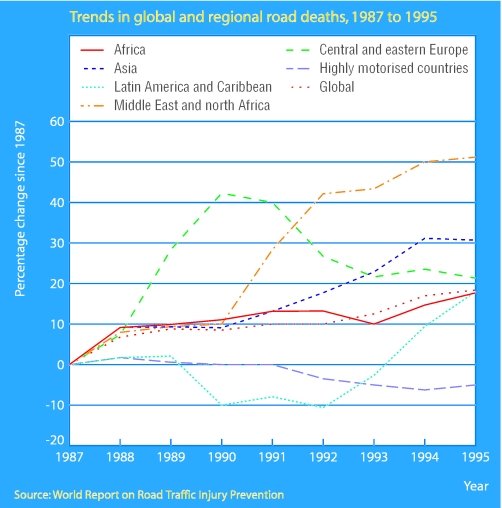Nearly 1.2 million people die each year on the world's roads, and the number will rise by 65% over the first two decades of this century, says a report published this week by the World Health Organization and the World Bank. Most of the extra deaths will occur in the developing world.
Figure 1.
Road traffic injuries and deaths are a major public health crisis that is being neglected by governments and the media, concludes the report, which was published on 7 April to mark world health day—dedicated this year to road safety.
In 2002 road traffic injuries represented 2.6% of the global burden from disease. Road deaths accounted for almost 23% of all deaths from injury, compared with 16.9% from suicide, 3.4% from war, and 10.8% from other violence.
WHO estimates that the number of people injured annually could be as high as 50 million. “The tragedy behind these figures,” says the report, “attracts less media attention than other, less frequent but more unusual types of tragedy.”
At the London inquest into the world's first automobile fatality in 1896 the coroner said: “This must never happen again.” Since then, 25 million people have died on the roads, says WHO.
In recent decades most developed countries have brought their death rates down, as a result of better trauma care, but the rapid spread of motorisation in the developing world has ensured that the global trend is upwards. India alone lost 217 000 people on its roads in 1998.
Britain now has the safest roads in the world, in terms both of deaths per capita and of deaths per kilometre travelled. In Britain 5.9 people out of every 100 000 inhabitants are killed on the roads each year, compared with 11 in the European Union as a whole, 8.2 in Japan, and 15.2 in the United States. In El Salvador the figure is 42.2.
The report argues that strategies aimed at modifying drivers' behaviour have been less effective at reducing road deaths than seat belts and environmental changes such as crash barriers. It calls for a concerted effort that would involve better medical and emergency care, random breath testing, safer cars, seat belt and helmet laws, and greater political will.
A 5-Year WHO Strategy for Road Traffic Injury Prevention can be accessed at www.who.int/world-health-day/2004



